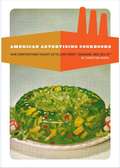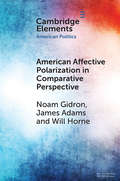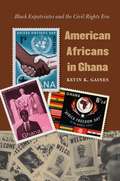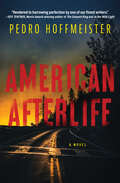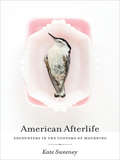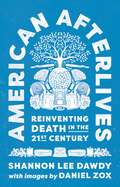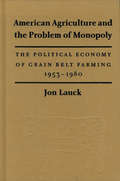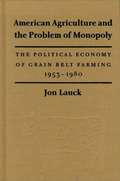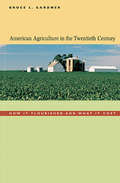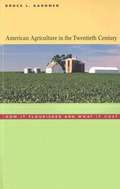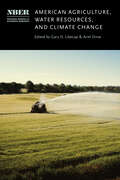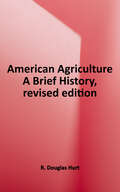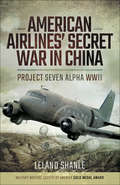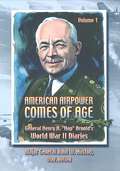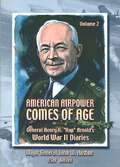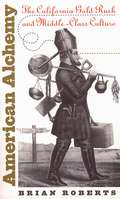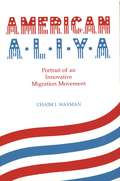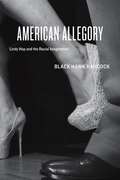- Table View
- List View
American Advertising Cookbooks: How Corporations Taught Us To Love Bananas, Spam, And Jell-o
by Christina WardAmerican Advertising Cookbooks: How Corporations Taught Us to Love Spam, Bananas, and Jell-O is a deeply researched and entertaining survey of twentieth century American food. Connecting cultural, social, and geopolitical aspects, author Christina Ward (Preservation: The Art & Science of Canning , Fermentation, and Dehydration, Process 2017) uses her expertise to tell the fascinating and often infuriating story of American culinary culture. Readers will learn of the role bananas played in the Iran-Contra scandal, how Sigmund Freud's nephew decided Carmen Miranda would wear fruit on her head, and how Puritans built an empire on pineapples. American food history is rife with crackpots, do-gooders, con men, and scientists all trying to build a better America-while some were getting rich in the process. Loaded with full-color images, Ward pulls recipes and images from her vast collection of cookbooks and a wide swath of historical advertisements to show the influence of corporations on our food trends. Though easy to mock, once you learn the true history, you will never look at Jell-O the same way again! American Advertising Cookbooks, How Corporations Taught Us To Love Bananas, Spam, and Jell&ndashO features full-color images and essays uncovering the origins of popular foods.
American Aesthetics: Theory and Practice (SUNY series in American Philosophy and Cultural Thought)
by Walter B. Gulick; Gary SlaterAlthough there are distinctly American artists—Walt Whitman, Herman Melville, Grandma Moses, Thomas Hart Benton, and Andy Warhol, for example—very little attention has been devoted to formulating any distinctively American characteristics of aesthetic judgment and practice. This volume takes a step in this direction, presenting an introductory essay on the possibility of such a distinctly American tradition, and a collection of essays exploring particular examples from a variety of angles. Some of the essays in this collection extend pragmatist and process insights about the important place aesthetics has in molding and assessing experience. Other essays examine the place of American aesthetics in relation to such particular forms of art as painting, literature, music, and film. Three essays attend to the aesthetic aspects of a flourishing life. In each of the essays, American aesthetics is understood to arise out of deeply felt personal, historical, and cultural backgrounds. Consequently, not only are such relatively abstract notions as harmony, fit, elegance, proportion, and the like involved in aesthetic judgment, but also religious, political, and social factors become embroiled in aesthetic discernment. Thus the ongoing pattern of American aesthetics is shown to be distinguishable from such other varieties of aesthetic thought as analytic aesthetics, New Criticism, and postmodern approaches to aesthetics.
American Affective Polarization in Comparative Perspective (Elements in American Politics)
by James Adams Noam Gidron Will HorneAmerican political observers express increasing concern about affective polarization, i.e., partisans' resentment toward political opponents. We advance debates about America's partisan divisions by comparing affective polarization in the US over the past 25 years with affective polarization in 19 other western publics. We conclude that American affective polarization is not extreme in comparative perspective, although Americans' dislike of partisan opponents has increased more rapidly since the mid-1990s than in most other Western publics. We then show that affective polarization is more intense when unemployment and inequality are high; when political elites clash over cultural issues such as immigration and national identity; and in countries with majoritarian electoral institutions. Our findings situate American partisan resentment and hostility in comparative perspective, and illuminate correlates of affective polarization that are difficult to detect when examining the American case in isolation.
American Africans in Ghana
by Kevin K. GainesIn 1957 Ghana became one of the first sub-Saharan African nations to gain independence from colonial rule. Over the next decade, hundreds of African Americans--including Martin Luther King Jr., George Padmore, Malcolm X, Maya Angelou, Richard Wright, Pauli Murray, and Muhammad Ali--visited or settled in Ghana. Kevin K. Gaines explains what attracted these Americans to Ghana and how their new community was shaped by the convergence of the Cold War, the rise of the U.S. civil rights movement, and the decolonization of Africa. Kwame Nkrumah, Ghana's president, posed a direct challenge to U.S. hegemony by promoting a vision of African liberation, continental unity, and West Indian federation. Although the number of African American expatriates in Ghana was small, in espousing a transnational American citizenship defined by solidarities with African peoples, these activists along with their allies in the United States waged a fundamental, if largely forgotten, struggle over the meaning and content of the cornerstone of American citizenship--the right to vote--conferred on African Americans by civil rights reform legislation.When the West African nation of Ghana gained its independence from British colonial rule in 1957, people of African descent the world over celebrated the new nation as a beacon for their aspirations for freedom and self-determination. Over the next decade, hundreds of African Americans--including Martin Luther King Jr., George Padmore, W. E. B. Du Bois, Malcolm X, Maya Angelou, Richard Wright, Pauli Murray, C. L. R. James, and Muhammad Ali--visited or settled in Ghana. Kevin K. Gaines explains what attracted these expatriates to Ghana and how their new community was shaped by the convergence of the Cold War, the rise of the U.S. civil rights movement, and the decolonization of Africa. -->
American Afterlife: A Novel
by Pedro HoffmeisterThe earthquake was just the beginning. Now, the true horror arrives in this unflinching, near-future thriller about family and survival, for fans of Chuck Wendig.The Pacific Northwest lies in ruins in the aftermath of the 9.2 Cascadia earthquake. There is a tsunami at the coast, annihilated infrastructure in all the towns and cities, and failed dams in the Oregon river valley where 15-year-old Cielo lives with her mother, a fearful evangelical who&’s become caught up in a fearsome cult called The Collection of Redeemed Souls. Cielo and her mother, Mexican citizens without U.S. papers, have always had their status teeter on the edge—and now it&’s about to plunge into the abyss.When the earthquake hits, Cielo&’s mother hasn&’t been home in days, but Cielo suspects that she&’s holed up with the cult and might even be dead. When the National Guard arrives to evacuate survivors, she stays behind in the flooded city to find her body. Members of The Collection of Redeemed Souls have also chosen to stay, and their disciples are capturing anyone still left behind and converting them to the cult by force. Entering a deadly game of cat-and-mouse, Cielo tries to evade the cult at every turn as she desperately searches for her mother&’s remains.With gunfights and mass killings engulfing the city, Cielo is one step away from her own demise, but the bonds of blood drive her on toward a confrontation with pure evil—and a final chance for her mother&’s redemption.
American Afterlife: Encounters in the Customs of Mourning
by Kate SweeneyAn award-winning writer explores the patchwork American cultural history of grieving the departed.One family inters their matriarch&’s ashes on the floor of the ocean. Another holds a memorial weenie roast each year at a green-burial cemetery. An 1898 ad for embalming fluid promises, &“You can make mummies with it!&” while a leading contemporary burial vault is touted as impervious to the elements. A grieving mother, 150 years ago, might spend her days tending a garden at her daughter&’s grave. Today, she might tend the roadside memorial she erected where her daughter was killed. One mother wears a locket containing her daughter&’s hair; the other, a necklace containing her ashes.What happens after someone dies depends on our personal stories and on where those stories fall in a larger tale―that of death in America. It&’s a powerful tale that we usually keep hidden from our everyday lives until we have to face it.American Afterlife by Kate Sweeney reveals this world through a collective portrait of Americans past and present who are personally involved with death: obit writers in the desert, an Atlantic funeral voyage, a fourth-generation funeral director―even a midwestern museum that shows us our death-obsessed Victorian progenitors. Each story illuminates details in another, revealing a landscape that feels at once strange and familiar, one that&’s by turns odd, tragic, poignant, and sometimes even funny.&“Sweeney&’s quest for the &“why&” behind mourning rituals has given us a book in the best tradition of narrative journalism.&”—Jessica Handler, author of Braving the Fire: A Guide to Writing about Grief and Loss
American Afterlives: Reinventing Death in the Twenty-First Century
by Shannon Lee DawdyA mesmerizing trip across America to investigate the changing face of death in contemporary lifeDeath in the United States is undergoing a quiet revolution. You can have your body frozen, dissected, composted, dissolved, or tanned. Your family can incorporate your remains into jewelry, shotgun shells, paperweights, and artwork. Cremations have more than doubled, and DIY home funerals and green burials are on the rise. American Afterlives is Shannon Lee Dawdy’s lyrical and compassionate account of changing death practices in America as people face their own mortality and search for a different kind of afterlife.As an anthropologist and archaeologist, Dawdy knows that how a society treats its dead yields powerful clues about its beliefs and values. As someone who has experienced loss herself, she knows there is no way to tell this story without also reexamining her own views about death and dying. In this meditative and gently humorous book, Dawdy embarks on a transformative journey across the United States, talking to funeral directors, death-care entrepreneurs, designers, cemetery owners, death doulas, and ordinary people from all walks of life. What she discovers is that, by reinventing death, Americans are reworking their ideas about personhood, ritual, and connection across generations. She also confronts the seeming contradiction that American death is becoming at the same time more materialistic and more spiritual.Written in conjunction with a documentary film project, American Afterlives features images by cinematographer Daniel Zox that provide their own testament to our rapidly changing attitudes toward death and the afterlife.
American Agriculture and the Problem of Monopoly: The Political Economy of Grain Belt Farming, 1953-1980
by Jon K. LauckThe breathtaking number of mergers and joint ventures among agribusiness firms has left independent American farmers facing the power of an increasingly concentrated buying sector. The origin of farmers’ concern with such economic concentration dates back to protests against meatpackers and railroads in the late nineteenth century. Jon Lauck examines the dimensions of this problem in the American Midwest in the decades following World War II. He analyzes the nature of competition within meat-packing and grain markets. In addition, he addresses concerns about corporate entry into production agriculture and the potential displacement of a production system defined by independent family farms. Lauck also considers the ability of farmers to organize in order to counter the market power of large-scale agribusiness buyers. He explores the use of farmer cooperatives and other mechanisms which may increase the bargaining power of farmers. The book offers the first serious historical examination of the National Farmers Organization, which fully embraced the bargaining power cause in the postwar period. Lauck finds that independent farmers’ attempts at organization have been more successful than previously recognized, but he also shows that their successes have been undermined by the growing concentration and power of agri-business firms, justifying a new approach to antitrust law in agricultural markets.
American Agriculture and the Problem of Monopoly: The political economy of grain belt farming, 1953-1980
by Jon LauckThe breathtaking number of mergers and joint ventures among agribusiness firms has left independent American farmers facing the power of an increasingly concentrated buying sector. The origin of farmers’ concern with such economic concentration dates back to protests against meatpackers and railroads in the late nineteenth century. Jon Lauck examines the dimensions of this problem in the American Midwest in the decades following World War II. He analyzes the nature of competition within meat-packing and grain markets. In addition, he addresses concerns about corporate entry into production agriculture and the potential displacement of a production system defined by independent family farms. Lauck also considers the ability of farmers to organize in order to counter the market power of large-scale agribusiness buyers. He explores the use of farmer cooperatives and other mechanisms which may increase the bargaining power of farmers. The book offers the first serious historical examination of the National Farmers Organization, which fully embraced the bargaining power cause in the postwar period. Lauck finds that independent farmers’ attempts at organization have been more successful than previously recognized, but he also shows that their successes have been undermined by the growing concentration and power of agri-business firms, justifying a new approach to antitrust law in agricultural markets.
American Agriculture in the Twentieth Century: How It Flourished and What It Cost
by Bruce L. GardnerAmerican agriculture in the twentieth century has given the world one of its great success stories, a paradigm of productivity and plenty. Yet the story has its dark side, from the plight of the Okies in the 1930s to the farm crisis of the 1980s to today's concerns about low crop prices and the impact of biotechnology. Looking at U.S. farming over the past century, Bruce Gardner searches out explanations for both the remarkable progress and the persistent social problems that have marked the history of American agriculture. Gardner documents both the economic difficulties that have confronted farmers and the technological and economic transformations that have lifted them from relative poverty to economic parity with the nonfarm population. He provides a detailed analysis of the causes of these trends, with emphasis on the role of government action. He reviews how commodity support programs, driven by interest-group politics, have spent hundreds of billions of dollars to little purpose. Nonetheless, Gardner concludes that by reconciling competing economic interests while fostering productivity growth and economic integration of the farm and nonfarm economies, the overall twentieth-century role of government in American agriculture is fairly viewed as a triumph of democracy.
American Agriculture in theTwentieth Century: How It Flourished and What It Cost
by Bruce L. GardnerAmerican agriculture in the twentieth century has given the world one of its great success stories, a paradigm of productivity and plenty. Yet the story has its dark side, from the plight of the Okies in the 1930s to the farm crisis of the 1980s to today's concerns about low crop prices and the impact of biotechnology. Looking at U. S. farming over the past century, Bruce Gardner searches out explanations for both the remarkable progress and the persistent social problems that have marked the history of American agriculture. Gardner documents both the economic difficulties that have confronted farmers and the technological and economic transformations that have lifted them from relative poverty to economic parity with the nonfarm population. He provides a detailed analysis of the causes of these trends, with emphasis on the role of government action. He reviews how commodity support programs, driven by interest-group politics, have spent hundreds of billions of dollars to little purpose. Nonetheless, Gardner concludes that by reconciling competing economic interests while fostering productivity growth and economic integration of the farm and nonfarm economies, the overall twentieth-century role of government in American agriculture is fairly viewed as a triumph of democracy.
American Agriculture, Water Resources, and Climate Change (National Bureau of Economic Research Conference Report)
by Gary D. Libecap and and Ariel DinarA collection of the most advanced and authoritative agricultural-economic research in the face of increasing water scarcity. Agriculture has been critical in the development of the American economy. Except in parts of the western United States, water access has not been a critical constraint on agricultural productivity, but with climate change, this may no longer be the case. This volume highlights new research on the interconnections between American agriculture, water resources, and climate change. It examines climatic and geologic factors that affect the agricultural sector and highlights historical and contemporary farmer responses to varying conditions and water availability. It identifies the potential effects of climate change on water supplies, access, agricultural practices, and profitability, and analyzes technological, agronomic, management, and institutional adjustments. Adaptations such as new crops, production practices, irrigation technologies, water conveyance infrastructure, fertilizer application, and increased use of groundwater can generate both social benefits and social costs, which may be internalized with various institutional innovations. Drawing on both historical and present experiences, this volume provides valuable insights into the economics of water supply in American agriculture as climate change unfolds.
American Agriculture: A Brief History
by R. Douglas HurtThis book is from the prehistoric period through the twentieth century and is written for anyone coming to this subject for the first time. American Agriculture is a story of considerable achievement and success, but it is also a story of greed, racism, and violence. Hurt offers a provocative look at a history that has been shaped by the best and worst of human nature. Here is the background essential for understanding the complexity of American agricultural history, from the transition to commercial agriculture during the colonial period to the failure of government policy following World War II. Complete with maps, drawings, and over seventy splendid photographs, this revised edition closes with an examination of the troubled landscape at the turn of the twenty-first century. It also provides a ready reference to the economic, social, political, scientific, and technological changes that have most affected farming in America and the contributions of African Americans, Native Americans, and women. This survey will serve as a text for courses in the history of American agriculture and rural studies as well as a supplementary text for economic history and rural sociology courses.
American Airline's Secret War in China: Project Seven Alpha, WWII
by Leland ShanleIn late 1941, President Roosevelt agonized over the rapid advances of the Japanese forces in Asia; they seemed unstoppable. He foresaw their intentions of taking India and linking up with the two other Axis Powers, Germany and Italy, in an attempt to conquer the Eastern Hemisphere. US naval forces had been surprised and diminished in Pearl Harbor and the army was not only outnumbered but also ill-prepared to take on the invading hoards. One of Roosevelts few options was to form a defensive line on the eastern side of the Patkai and Himalayan Ranges; there, he could look for support from the Chinese and Burmese. It was the only defence to a Japanese invasion of India.To support and supply the troops who were fighting in hostile jungle terrain, where overland routes had been cut off, he desperately needed to set up an air supply from Eastern India. His problem was lack of aircraft and experienced pilots to fly the dangerous Hump, over the worlds highest mountains. Hence the inception of Operation Seven Alpha, a plan to enlist the aircraft—DC-3s—and the pilots—veterans of World War One—of American Airlines. This newly formed elite Squadron would fly the medium-range aircraft in a series of long-distance hops across the Pacific and Southern Asia to the Assam Valley in India. They would then create and operate the vital supply route, carrying arms, ammunition and food Eastward to the Allied bases, before returning with wounded personnel. This is the story of that little-known operation, carried out in the early days of the Burma Campaign.The book is based on first-hand experiences of those who were involved, and it serves as a fitting tribute to the bravery and inventiveness of a band of men who answered their countrys desperate call at the outset of the war against Japan in Asia.
American Airlines in 2011
by Willy ShihThe American Airlines in 2011 case was developed to provide a setting for the comparative analysis of two very different business models in the U.S. domestic airline industry-the network carrier and the low cost carrier (LCC). These models offer very different value propositions. Firms allocate resources into distinctively different processes, and they earn returns using parallel but different profit models. Yet while most scholars view the LCC model as disruptive, the two different models have been able to co-exist for over forty years, albeit with substantial evolution. By unpacking how one of the major network carriers was able to evolve its model successfully for such a long time before industry structural changes necessitated a radical overhaul, the cases seek to give students insights into how the different business models were established, how competitive forces have driven their evolution, and the importance of constantly evolving and tuning a firm's model.
American Airlines' Value Pricing (A)
by Alvin J. Silk Steven C. MichaelIn April 1992, American Airlines launched "Value Pricing" -- a radical simplification of the complex pricing structure that had evolved over more than a decade following deregulation of the U.S. domestic airline industry. American expected that the new pricing structure would benefit consumers and restore profitability to both American and the industry as a whole. The critical issue raised is: Would American's bold initiative work?
American Airlines, Inc.: Revenue Management
by Adam Brandenburger Anirudh DhebarBegins with a description of the elements of post-deregulation competition in the commercial airline industry. This should facilitate a discussion of the use of quantitative methods to support a broad range of tactical and strategic airline decisions. The principal thrust of the case is on revenue management. First, there is a description of the principal pricing concepts, followed by two examples of pricing decisions facing American. Next, there is a discussion of the basic yield management concepts and comments on the challenges in their implementation. Finally, there is a brief write-up on the structure and future of the revenue management organization.
American Airpower Comes Of Age—General Henry H. “Hap” Arnold’s World War II Diaries Vol. I [Illustrated Edition] (General Henry H. “Hap” Arnold’s World War II Diaries #1)
by Maj.-Gen John W. Huston Gen. Henry H. “Hap.” ArnoldIncludes the Aerial Warfare In Europe During World War II illustrations pack with over 180 maps, plans, and photos.Gen Henry H. "Hap." Arnold, US Army Air Forces (AAF) Chief of Staff during World War II, maintained diaries for his several journeys to various meetings and conferences throughout the conflict. Volume 1 introduces Hap Arnold, the setting for five of his journeys, the diaries he kept, and evaluations of those journeys and their consequences. General Arnold's travels brought him into strategy meetings and personal conversations with virtually all leaders of Allied forces as well as many AAF troops around the world. He recorded his impressions, feelings, and expectations in his diaries. Maj Gen John W. Huston, USAF, retired, has captured the essence of Henry H. Hap Arnold--the man, the officer, the AAF chief, and his mission. Volume 2 encompasses General Arnold's final seven journeys and the diaries he kept therein.
American Airpower Comes Of Age—General Henry H. “Hap” Arnold’s World War II Diaries Vol. II [Illustrated Edition] (General Henry H. “Hap” Arnold’s World War II Diaries #2)
by Maj.-Gen John W. Huston Gen. Henry H. “Hap.” ArnoldIncludes the Aerial Warfare In Europe During World War II illustrations pack with over 180 maps, plans, and photos.Gen Henry H. "Hap." Arnold, US Army Air Forces (AAF) Chief of Staff during World War II, maintained diaries for his several journeys to various meetings and conferences throughout the conflict. Volume 1 introduces Hap Arnold, the setting for five of his journeys, the diaries he kept, and evaluations of those journeys and their consequences. General Arnold's travels brought him into strategy meetings and personal conversations with virtually all leaders of Allied forces as well as many AAF troops around the world. He recorded his impressions, feelings, and expectations in his diaries. Maj Gen John W. Huston, USAF, retired, has captured the essence of Henry H. Hap Arnold--the man, the officer, the AAF chief, and his mission. Volume 2 encompasses General Arnold's final seven journeys and the diaries he kept therein.
American Alchemy
by Brian RobertsCalifornia during the gold rush was a place of disputed claims, shoot-outs, gambling halls, and prostitution; a place populated by that rough and rebellious figure, the forty-niner; in short, a place that seems utterly unconnected to middle-class culture. In American Alchemy, however, Brian Roberts offers a surprising challenge to this assumption.Roberts points to a long-neglected truth of the gold rush: many of the northeastern forty-niners who ventured westward were in fact middle-class in origin, status, and values. Tracing the experiences and adventures both of these men and of the "unseen" forty-niners--women who stayed back East while their husbands went out West--he shows that, whatever else the gold seekers abandoned on the road to California, they did not simply turn their backs on middle-class culture.Ultimately, Roberts argues, the story told here reveals an overlooked chapter in the history of the formation of the middle class. While the acquisition of respectability reflects one stage in this history, he says, the gold rush constitutes a second stage--a rebellion against standards of respectability.
American Aliya: Portrait of an Innovative Migration Movement
by Chaim I. WaxmanThe major focus is on the who, when, and where of American immigration to Israel, but it is the "why" of this aliya which constitutes the core of the book. Waxman analyzes the relationship between Zionism, aliya, and the Jewish experience. Chapters include "Zion in Jewish culture," a synopsis of Zionism through the years, and "American Jewry and the land of Israel in the Eighteenth and Nineteenth Centuries," an account of proto-Zionist ideas and movements in early America. Chaim I. Waxman delivers a broad analysis of the phenomenon of American migration to Israel - aliya. Working within the context of the sociology of migration, Waxman provides primary research into a variety of dimensions of this movement and demonstrates the inadequacy of current migration theories to characterize aliya.
American Allegory: Lindy Hop and the Racial Imagination
by Black Hawk HancockOC Perhaps, OCO wrote Ralph Ellison more than seventy years ago, OC the zoot suit contains profound political meaning; perhaps the symmetrical frenzy of the Lindy-hop conceals clues to great potential power. OCO As Ellison noted then, many of our most mundane cultural forms are larger and more important than they appear, taking on great significance and an unexpected depth of meaning. What he saw in the power of the Lindy HopOCothe dance that "Life "magazine once billed as OC AmericaOCOs True National Folk DanceOCOOCowould spread from black America to make a lasting impression on white America and offer us a truly compelling means of understanding our culture. But with what hidden implications? In "American Allegory," Black Hawk Hancock offers an embedded and embodied ethnography that situates dance within a larger Chicago landscape of segregated social practices. Delving into two Chicago dance worlds, the Lindy and SteppinOCO, Hancock uses a combination of participant-observation and interviews to bring to the surface the racial tension that surrounds white use of black cultural forms. Focusing on new forms of appropriation in an era of multiculturalism, Hancock underscores the institutionalization of racial disparities and offers wonderful insights into the intersection of race and culture in America.
American Alligator: Ancient Predator in the Modern World
by Kelby OuchleyHaving survived since the Mesozoic era, alligators teetered on the brink of extinction in the 1960s. Their recovery in the 1970s was largely due to legislative intervention, and today populations are closely monitored throughout their range. American Alligator is the most up-to-date and comprehensive treatment of this resilient relic, a creature with a brain weighing less than half an ounce that has successfully adapted to a changing Earth for more than 200 million years.Kelby Ouchley chronicles the evolution of A. mississippiensis from "shieldcroc"--the last common ancestor of modern-day alligators, crocodiles, caimans, and gavials--to its current role as keystone of the ecological health of America's southern swamps and marshes. In Florida, the apex predator uses its snout and feet to clear muck from holes in the limestone bedrock. During the dry season, these small ponds or "alligator holes" provide refuge, food, and water for a variety of wildlife. In Louisiana, millions of dollars are spent on the bounty of the non-native nutria that overgraze marsh vegetation, but alligators prey on these coastal rodents free of charge.The loss of the American alligator would be a blow to biodiversity and an ecosystem disruption affecting all levels of the food chain. While the U.S. Fish and Wildlife Service removed it from the endangered species list in 1987 and today regulates the legal trade of the animal and its products, Ouchley cautions us not to forget the lessons learned: human activities, from urban development to energy production, can still threaten the future of the gator and its southern wetland habitat.
American Alligators (North American Animals Ser.)
by Steve PottsAmerican alligators live only in North America. Learn all about these big mouthed biters and their habitats in American Alligators.
